Ijraset Journal For Research in Applied Science and Engineering Technology
- Home / Ijraset
- On This Page
- Abstract
- Introduction
- Conclusion
- References
- Copyright
Automated Structural Health Monitoring System for Mitigating Building Collapse in Nigeria: A Mobile App Approach
Authors: Edemirukaye U. Orodje, Eden Emmanuel. , Adegboyega Israel. A
DOI Link: https://doi.org/10.22214/ijraset.2024.60009
Certificate: View Certificate
Abstract
Building collapses have become a distressing and recurring issue in Nigeria, necessitating urgent action to mitigate their occurrence. This paper introduces an innovative approach to address this challenge by developing an Automated Structural Health Monitoring System (ASHMS) utilizing a mobile app. Focusing on major cities like Lagos and Abuja, the proposed system employs strategically placed sensors to gather data from various structural elements of buildings. The collected information, encompassing seismic activity, vibrations, bending moments, shear forces, and other key parameters, is wirelessly transmitted to the cloud where it can then be accessed and visualized using mobile app. The system offers real-time insights into the structural integrity of buildings and provides early warnings, thereby contributing significantly to reducing the risk of building collapses. Key findings show that when incorporated into an automated Structural Health Monitoring (SHM) system, the user\'s mobile app offers essential structural insights, capturing values such as a 0.5-unit vibration level, 20 units of shear force, 50 units of bending moment, and an 89-degree vertical wall angle. The app\'s user-friendly interface improves the effectiveness of monitoring and overseeing structural health, in line with the overarching objective of promoting safety in construction practices.
Introduction
I. INTRODUCTION
In recent years, Nigeria's construction industry has witnessed significant growth attributed to urbanization and population expansion [1]. However, this development has been accompanied by a disturbing rise in building collapses, posing severe threats to life, property, and economic stability.
The construction sector in Nigeria, involving architects, governments, private developers, landlords, and users, confronts a substantial challenge [4]. Notably, Abuja and Lagos have experienced a disturbingly high frequency of building collapses, exemplified by incidents like the Nigeria Industrial Development Building (NIDB) in Lagos in 2006 and a two-storey market plaza in Oshodi, Lagos, in 2010 [5]. A particularly alarming case unfolded in Surulere, Lagos State, in July 2006, where three buildings collapsed, resulting in at least 29 deaths and severe injuries to 48 others [6]. Another tragic incident occurred in Lagos in 2006, claiming 37 lives in a four-storey building mishap in Ebute Meta [6].
In September 2014, over 118 worshipers lost their lives in a collapsed six-storey building at the Synagogue Church of All Nations (SCOAN) in Lagos State [8]. Additionally, in 2011, a collapse in Gimbiya Street, Area 11 Garki, Abuja, resulted in the deaths of five people, including a pregnant woman, with over 40 squatters trapped in the house. Another two-storey building collapse occurred in Abuja, Nigeria [9]. The scenes of building collapses are disheartening and tragic (refer to Figures 1.1-1.2 below), often associated with the loss of life, investments, time, equipment, and waste of building materials. Furthermore, it adversely affects the reputation of the construction industry in the area.
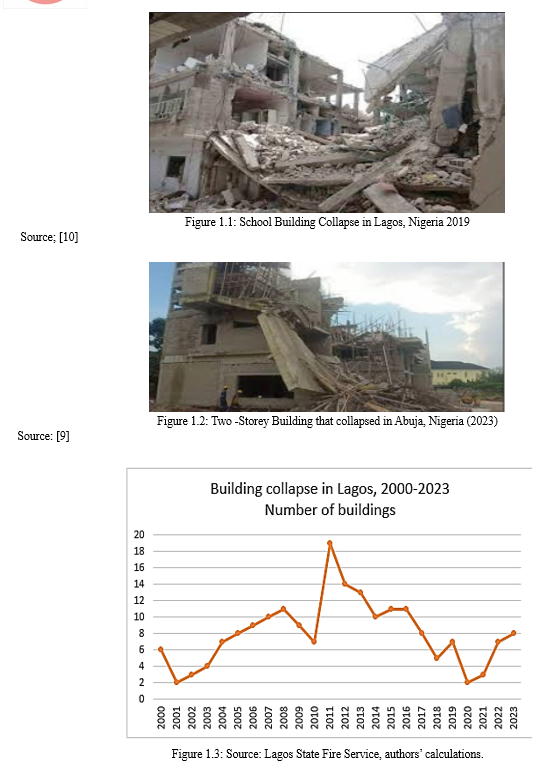
These incidents not only resulted in the loss of lives and property but also caused significant economic setbacks (Ibidun, 2020). The absence of effective tools for detecting and preventing building collapses impedes sustainable development and safety practices. The building collapse crisis in Nigeria is attributed to factors such as poor construction practices, inadequate supervision, the use of substandard materials, and a lack of maintenance.
In contrast to manual methods prone to human error, this study advocates for automation in structural monitoring. An automated system, equipped with strategically placed sensors within the structure, can continuously collect data, providing real-time insights into its health. This shift towards automation aims to enhance the effectiveness and reliability of structural health monitoring, ultimately contributing to the prevention of building collapses in Nigeria.
Recognizing the necessity for Structural Health Monitoring (SHM), this study underscores SHM as a crucial solution to prevent building collapses. By continuously assessing and analyzing the structural condition of buildings, SHM allows for early detection of potential issues, facilitating timely interventions and maintenance. Cloud services and mobile app technology have transformed SHM into a scalable and accessible solution. With the widespread adoption of mobile devices, mobile apps can serve as user-friendly interfaces for building owners and regulatory authorities to monitor and manage structural health efficiently.The pursued specific objectives include:
- Identifying the primary reasons for building collapses in cities in Nigeria;
- Creating a network of compact sensors to capture crucial structural data;
- Establishing wireless communication between the sensors and cloud services;
- Establishing a cloud service for the storage and processing of sensor data;
- Creating a mobile app for visualization and analysis of reports.
II. RELATED LITERATURE
In 2019, Fidelis O.A and Colleagues Combining multicriteria decision analysis with GIS for suitably siting landfills in a Nigerian state, to enhance building safety in Nigeria through the integration of GIS data with structural health monitoring. The results showcased improved visualization and analysis of building health data using GIS [11].
However, a research gap was identified: there's inadequate exploration of the potential of GIS in predicting and preventing building collapses. Moving to 2021, P. Mehta and Friends conducted a study on " Building MedVenture – A mobile health application to improve adolescent medication adherence in Nigeria." Their goal was to evaluate the usability and acceptance of a mobile app-based monitoring system among Nigerian professionals [12]. Positive feedback on usability and acceptance emerged from the results, but a research gap was identified: insufficient exploration of user preferences and challenges that might affect widespread adoption.
In the same year, Ebekozien and colleagues delved into the "Social Sustainability of Building Failures in Lagos, Nigeria: A Structural Health Monitoring Perspective." Utilizing economic analysis and interviews, they aimed to assess the socioeconomic impact of building collapses in Nigeria and the potential contribution of structural health monitoring [7]. The results revealed significant economic and social consequences, but a research gap was identified: a limited understanding of how monitoring systems can effectively mitigate these consequences. Fast-forwarding to 2023, M. Oni and Colleagues focused on "Challenges and Opportunities in Implementing Automated Structural Health Monitoring in the Nigerian Construction Industry." Through literature review and case studies, their aim was to identify challenges and opportunities associated with adopting automated monitoring systems in Nigerian construction [13]. The results highlighted barriers and potential strategies for successful implementation. However, a research gap was identified: insufficient exploration of the socio-economic implications of these challenges. In 2024, O. Olushina with Friends conducted research on "Machine Learning Applications in Building Collapse Prediction: A Nigerian Perspective," employing machine learning algorithms and historical data analysis [14]. Their aim was to develop predictive models for early detection of building collapse risks in Nigeria. The results demonstrated high accuracy in predicting potential building collapse risks, yet a research gap was noted: limited exploration of the model's performance in diverse Nigerian geographical and structural settings. R. Katam and two others, in 2023, did "Review on Structural Health Monitoring in Nigerian Buildings," using data fusion algorithms and simulation [15]. Their aim was to enhance the accuracy and reliability of structural health monitoring. The results demonstrated enhanced precision in health assessments, but a research gap was identified: insufficient exploration of the impact of diverse building materials on data fusion accuracy.
Finally, in the same year, A. Adefemi and Colleagues explored "Community Engagement and Participatory Structural Health Monitoring for Building Safety in Nigeria," utilizing surveys, focus groups, and participatory methods [16].
Their aim was to understand the role of community engagement in the successful implementation of structural health monitoring systems. The results highlighted the importance of involving local communities, but a research gap was recognized: a limited understanding of the scalability of community engagement models.
The traditional method was to carry out visual inspection and calculation as detailed below:
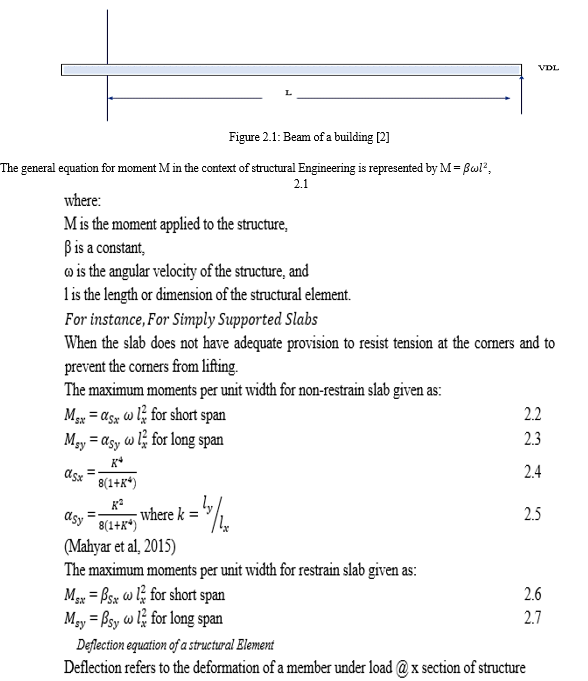

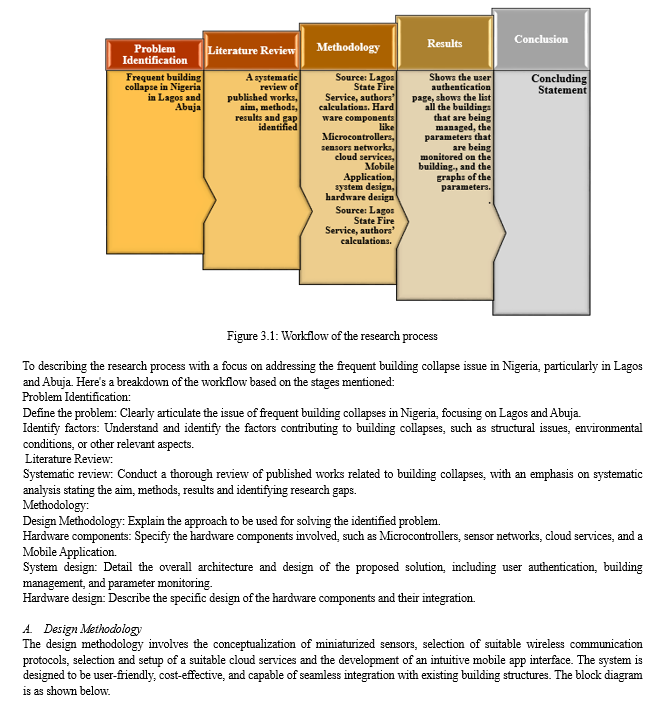
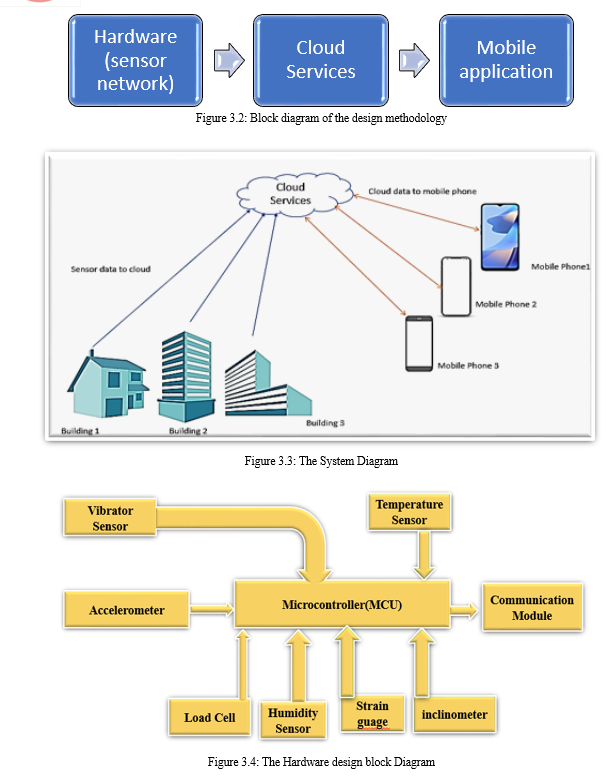
B. Hardware Design
The hardware of ASHMS consists of sensors, a microcontroller and a wireless communication module.
- Proposed Sensors
The proposed sensors that can be used for the Automated Structural Health Monitoring System for mitigating building collapse in Nigeria, utilizing a mobile app approach are as follows:
- Accelerometers: Measure acceleration forces caused by vibrations or movement, helping detect structural shifts or potential collapses.
- Strain Gauges: Monitor strain or deformation in building components to identify overstressed areas.
- Temperature Sensors: Detect temperature variations that could lead to material degradation or weakening.
- Humidity Sensors: Monitor humidity levels to prevent moisture-related deterioration and corrosion.
- Load Cells: Measure loads or weights applied to structural elements to ensure they're within safe limits.
- Inclinometers: Determine tilting or leaning of structures, indicating potential instability.
- Vibration Sensors: Detect vibrations caused by external factors or structural issues that could lead to collapse.
2. The Microcontroller (MCU)
The microcontroller to be used in the ASHMS hardware must have the required computation capacity and speed to handle all the sensor inputs and send the data to the communication module in real-time. STM32F4 series of microcontrollers is recommended as they are 32bit MCUs with good performance. An ESP32 series from Expressif can also be used. The later comes with extra advantage as it has inbuilt communication module based on Wi-Fi and Bluetooth.
3. Communication Module
The recommended communication module for ASHMS is one internet capability. A Wi-Fi based module is a good choice. GSM/3G modules form SIMCOM (e.g SIM800) are also good choices as eliminate the need for Wi-Fi routers and communicate directly with the internet.
4. Cloud Service Design
The cloud services recommended for this project is a serverless function. This can be gotten from the major cloud services providers (e.g. AWS, Azure, GCP, DigitalOcean etc). The serverless function will run custom logic to process the data from the sensors and store it to the database and also process the data for inferences and easy visualization before sending it to the mobile app. User authentication is also performed in the serverless function. Recommended storage solution is a InfluxDB which is a time-series database. This provides the advantage of easy storage and fast query of data based on time and other properties.
5. Mobile Application
For best performance on the mobile application, native development is recommended. The Android application will be developed using the official Android SDK. This will help to take advantage of all the native visualization libraries (AAChartCore, HelloCharts, etc) with very responsive user interaction.
IV. RESULTS
The results of the suggested mobile app display a user authentication page, prompting users to log in with a username and password. Subsequently, it presents a comprehensive list of managed buildings and the monitored parameters within each building. Following this, graphical representations of the monitored parameters (refer to Figures 3.5-3.8) are showcased below.
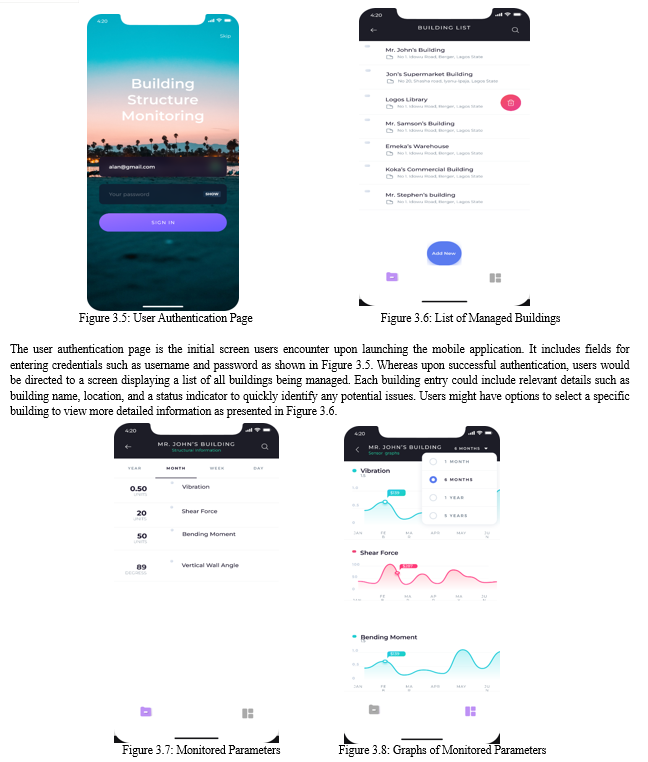
Figure 3.7 shows the Monitored Parameters that upon selecting a particular building, users would navigate to a screen showing the parameters being monitored for that specific building. Parameter include structural conditions, environmental factors, or any other relevant metrics contributing to the risk of building collapse. The information presented in a good format with clear labels and values. Whereas the graphs of monitored parameters screen presents graphical representations of the monitored parameters for enhanced data visualization. Graphs are line chart showing the trends and fluctuations of the parameters over time. Users can interpret the graphs to identify patterns or anomalies that might indicate potential risks or issues with the building's structural integrity as shown in Figure 3.8. Overall, these screens collectively provide users with a comprehensive tool for monitoring and managing buildings, aiming to address the frequent building collapse issue in Nigeria, especially in Lagos and Abuja. The design prioritizes user authentication, building management, and detailed monitoring of key parameters to ensure a holistic and effective solution.
V. DISCUSSION
The results on the user's mobile app reveal vital structural indicators for an automated Structural Health Monitoring (SHM) system. Recorded values encompass a vibration level of 0.5 units, shear force at 20 units, bending moment reaching 50 units, and a vertical wall angle measuring 89 degrees. These readings are pivotal in evaluating the structural integrity of buildings. A vibration level of 0.5 units implies a fairly stable structure, while a sheer force of 20 units and a bending moment of 50 units highlight the exerted forces, requiring attention to ensure they fall within safe limits. The 89-degree vertical wall angle offers insights into structural alignment, with any deviation potentially indicating an issue.
The mobile app's capability to instantly showcase and assess these parameters is a fundamental aspect of an automated SHM system. This method enables early identification of anomalies or potential structural concerns, allowing for prompt interventions and preventive actions to mitigate the risk of building collapses in Nigeria. The app's user-friendly interface facilitates effective monitoring and management of structural health, contributing to the overarching objective of enhancing safety in construction practices.
Conclusion
This paper addresses the alarming issue of building collapses in Nigeria by introducing an innovative Automated Structural Health Monitoring System (ASHMS) utilizing a mobile app. Focused on major cities like Lagos and Abuja, the system strategically places sensors to collect data on various structural elements, transmitting the information wirelessly to the cloud for real-time access and visualization through the mobile app. The findings indicate that the mobile app, integrated into an automated Structural Health Monitoring (SHM) system, provides crucial structural insights, including vibration level, shear force, bending moment, and vertical wall angle. These indicators play a vital role in evaluating structural integrity, with the app\'s user-friendly interface facilitating effective monitoring and management. The methodology involves problem identification, literature review, sensor integration, data collection, and real-time assessments, leading to promising results in early detection of structural issues. The implications suggest that this approach contributes significantly to mitigating the risk of building collapses in Nigeria, with potential enhancements and further research avenues outlined for the critical area of infrastructure safety.
References
[1] Kyle F., \"An Inquiry into the Nature and Causes of Nigeria’s Rapid Urban Transition,\" Springer, pp. 277-298, 2018. [2] Mahyar M., Abdukadir C., and Merves S., \"Investigation of innovative steel runway beam in industrial building,\" Springer, pp. 2239-2251, 2015. [3] Ibidun , \"Urban dynamics, everyday hazards and disaster risks in Ibadan, Nigeria,\" SAGE, 2020. [4] Chendo, I.G. and Obi, N.I. “Building collapse in Nigeria: the causes, effects, consequences and remedies”, International Journal of Civil Engineering, Construction and Estate Management. 3 (4) 41–49, 2015. [5] Olagunju, R.E., Aremu, S.C., and Ogundele, J. “Incessant Collapse of Buildings in Nigeria: An Architect’s View”. Journal of Civil and Environmental Research. 3(4), ISSN 2225-0514, 2013. [6] Baje, A. (2019) Lagos building collapse; another avoidable tragedy. The Guardian News, 10 April 2019 [7] Ebekozien, A., Aigbavboa, C. and Samsurijan, M.S. , \"Social sustainability under threat: a case of two collapsed buildings in Lagos, Nigeria\", Property Management, 41(3), 431-453. (2021) [8] NAN “Synagogue church building in perfect condition before the building collapse, the witness said. The Guardian News, 21 June 2019. [9] Abdullahi Y. and Oluwafemi K. A “Evaluation of Building Condition and Maintenance as a Panacea for Preventing Building Collapse in Nigeria”: The Case for Correctional Buildings. 9(2) 52-60, 2023. [10] Rayyan, A. “ Over 100 pupils perish in Lagos school building collapse”. Daily Nigerian News 13th March 2019 Available online @ https://dailynigerian.com (Accessed 1st July 2020) [11] Fidelis O. Ajibade, Olabanji O. Olajire, Temitope F. Ajibade, Nathaniel A. Nwogwu, Kayode H. Lasisi, Ayopo B. Alo, Titilayo A. Owolabi, James R. Adewumi (2023). Combining multicriteria decision analysis with GIS for suitably siting landfills in a Nigerian state, Environmental and Sustainability Indicators, 3 (4), 2023, [12] Mehta P, Moore SL, Bull S, Kwan BM. “Building MedVenture – A mobile health application to improve adolescent medication adherence – Using a multidisciplinary approach and academic–industry collaboration”. DIGITAL HEALTH. 7(1), 2021. [13] [Oni, O.Z., Olanrewaju, A., Khor, S.C. and Akinbile, B.F. \"A comparative analysis of construction workers’ mental health before and during COVID-19 pandemic in Nigeria\", Frontiers in Engineering and Built Environment, 3 (1), 63-75, 2023. [14] Olushina Olawale Awe, Emmanuel Olawaseyi Atofarati, Michael Oluwadare Adeyinka, Ann Precious Musa & Esther Oluwatosin Onasanya. “Assessing the factors affecting building construction collapse casualty using machine learning techniques: a case of Lagos, Nigeria”, International Journal of Construction Management, 24:3, 261-269, 2024. [15] Katam, R., Pasupuleti, V.D.K. & Kalapatapu, P. “ A review on structural health monitoring: past to present”. Innov. Infrastruct. Solut. 8, 248, 2023. [16] Adefemi Aka, Bankole Awuzie, Fidelis Emuze, Abdullateef Adewale Shittu. “Evaluating the effectiveness of strategies for implementation of health and safety programs on construction sites in Nigeria: A mixed-method study”. Journal of Safety Research, 85(1), 172-181, 2023,
Copyright
Copyright © 2024 Edemirukaye U. Orodje, Eden Emmanuel. , Adegboyega Israel. A. This is an open access article distributed under the Creative Commons Attribution License, which permits unrestricted use, distribution, and reproduction in any medium, provided the original work is properly cited.

Download Paper
Paper Id : IJRASET60009
Publish Date : 2024-04-08
ISSN : 2321-9653
Publisher Name : IJRASET
DOI Link : Click Here
 Submit Paper Online
Submit Paper Online

